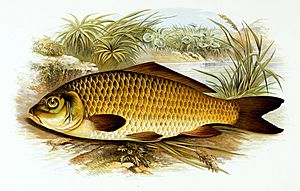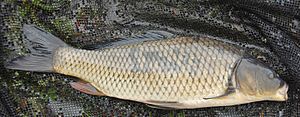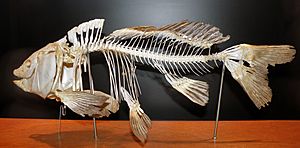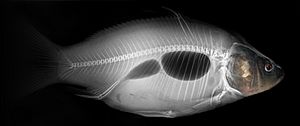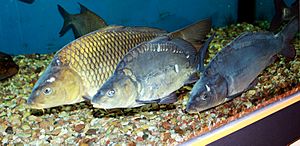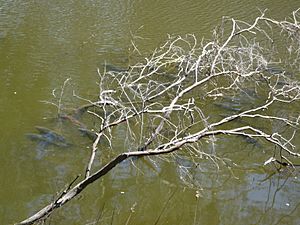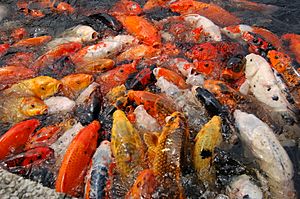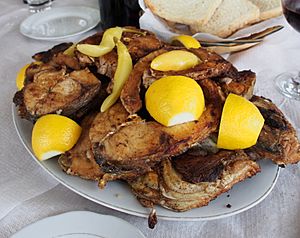Common carp facts for kids
Quick facts for kids Common carp |
|
|---|---|
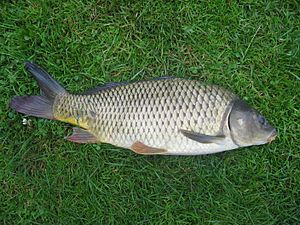 |
|
| Conservation status | |
| Scientific classification | |
| Genus: |
Cyprinus
|
| Species: |
carpio
|
The common carp or European carp (Cyprinus carpio) is a well-known freshwater fish. It lives in lakes and large rivers across Europe and Asia. These fish prefer waters rich in nutrients, like those found in many lakes.
Wild common carp populations are considered vulnerable to disappearing. This means they are at risk of extinction. However, people have also raised these fish for food for a very long time. They have been moved to many places around the world. In some areas, they are even seen as a harmful invasive species. This means they can cause problems for local fish and their environment. The common carp gives its name to the carp family, called Cyprinidae.
Contents
What is a Common Carp?
There are two main types, or subspecies, of common carp:
- C. c. carpio lives in much of Europe. You can find it in rivers like the Danube and Volga.
- C. c. yilmaz (also called Deniz carp) comes from Anatolian Turkey. It is found around Çorum.
In the past, a third type from eastern Asia was thought to be a subspecies. But now, scientists believe it is a separate species called C. rubrofuscus. Common carp can breed with other carp types. They can even breed with goldfish (Carassius auratus). The fish that results from this mix is called a Kollar carp.
History of the Common Carp
Common carp originally came from Europe and Asia. But people have moved them to almost every part of the world. They are the third most common fish species introduced by humans worldwide. People have been farming carp for food since Roman times.
Carp are eaten in many places. But in some regions, they are seen as a pest. This is because they can out-compete native fish for food and space. The first common carp lived in the Danube River about 2,000 years ago. They were shaped like a torpedo and had a golden-yellow color. They also had two pairs of whiskers, called barbels, and a mesh-like pattern of scales.
The Romans kept these fish in large, special ponds. As farming fish became popular, people started to breed them. They built ponds just for carp to lay eggs and grow. The common carp's natural home also includes the Black Sea, Caspian Sea, and Aral Sea.
Both European and Asian types of carp have been domesticated. This means they have been bred by humans for specific traits. In Europe, monks helped spread carp farming between the 13th and 16th centuries. Different types of carp have appeared through this breeding. These include:
- Mirror carp: These have large, shiny scales that look like mirrors. They often have rows of scales along their sides.
- Leather carp: These have very few scales, mostly near their top fin.
- Fully scaled carp: These are covered in scales, just like wild carp.
Koi carp are a special type of domesticated carp. They are raised for their beautiful colors and patterns. Koi first came from Japan in the 1820s. Their wild relatives are likely East Asian carp, possibly C. rubrofuscus.
About the Carp's Body
Wild common carp are usually thinner than carp raised by humans. Their body length is about four times their height. They have reddish meat and a mouth that sticks out. Common carp can grow very large if they have enough space and food.
Wild carp do not get as big as domesticated carp. Domesticated carp can grow up to 120 centimeters (about 4 feet) long. They can weigh over 40 kilograms (about 88 pounds). The oldest carp ever recorded lived for 38 years. The biggest carp ever caught weighed 45.59 kilograms (about 100.5 pounds). This fish was caught in France in 2013. Most common carp are about 40–80 centimeters (16-31 inches) long. They usually weigh between 2–14 kilograms (4.5-31 pounds).
Where Carp Live
Common carp can live in many different conditions. But they prefer large areas of slow-moving or still water. They like soft, muddy bottoms with lots of plants. Carp are schooling fish, meaning they like to be in groups. They prefer to be with five or more other carp.
They naturally live in places with mild climates. They can be found in fresh water or slightly salty water. The water should have a pH between 6.5 and 9.0. They can handle temperatures from 3°C to 35°C (37°F to 95°F). The best temperature for them is 23°C to 30°C (73°F to 86°F). They start laying eggs when the water is about 17°C to 18°C (63°F to 64°F). Carp can even survive winter in a frozen pond. They just need some unfrozen water below the ice. They can also live in water with very little oxygen. They do this by gulping air from the surface.
What Carp Eat
Common carp are omnivores. This means they eat both plants and animals. They can eat water plants. But they prefer to search the bottom for food. They look for insects, small crustaceans (like tiny water bugs), crawfish, and worms that live in the mud.
How Carp Reproduce
Carp lay eggs. A female carp can lay as many as 300,000 eggs at one time. Carp usually lay eggs in the spring. This happens when the water gets warmer and after it rains. But they can lay eggs multiple times in a season. In fish farms, people sometimes give carp a special injection. This helps them lay more eggs.
Who Eats Carp?
A single carp can lay over a million eggs in a year. But many eggs and young fish do not survive. They are eaten by bacteria, fungi, and many small predators in the pond. Young carp that do survive are hunted by other fish. These include the northern pike and largemouth bass. Many birds also eat carp, such as cormorants, herons, and ospreys. Mammals like otters and mink also prey on them.
Carp in New Places

Common carp have been introduced to most continents and about 59 countries. In places where they have no natural enemies or fishing, they can change the environment a lot. This is because they reproduce quickly. They also dig through the bottom sediments to find food. When they feed, they can destroy water plants. This harms native ducks and other fish.
Carp were brought to Australia over 150 years ago. But they only became a big problem in the 1960s. They spread widely through the Murray–Darling basin after big floods in 1974. Now, they are found in almost every part of Australia. In some areas, like Victoria, common carp are considered a harmful fish. There is no limit to how many a fisher can catch. In South Australia, it is against the law to release them back into the wild. One Australian company even makes plant fertilizer from carp.
Scientists have tried different ways to control carp. One idea was to use a virus called koi herpes virus. This virus makes carp sick and can kill them. In 2016, the Australian Government planned to release this virus into the Murray-Darling basin. The goal was to reduce the number of invasive carp. However, by 2020, it seemed this plan might not work. The CSIRO has also found a way to change carp genetically. This makes them only produce male offspring. This "daughterless carp" method could help get rid of carp from Australia's waterways completely.
Common carp arrived in the United States in 1831. In the late 1800s, the government spread them widely as a food fish. But today, people in the U.S. rarely eat them. They are often seen as pests. Just like in Australia, carp have caused environmental problems in the U.S.
In Utah, people are trying to reduce the carp population in Utah Lake. They use nets to catch millions of them. These carp are then given to people to eat or turned into fertilizer. This helps a native fish called the June sucker recover. Another way to control carp is to trap them in small rivers where they lay eggs. Then, they are exposed to a fish poison called rotenone. This method quickly reduces their numbers. It also helps native plants and fish grow back.
Carp are thought to have come to British Columbia, Canada, from Washington state. They were first seen in the Okanagan Valley in 1912. Their population grew very fast. Carp are now found in several river systems in British Columbia.
In 2020, scientists found something interesting. A small number of carp eggs can survive being eaten by water birds. These eggs can hatch after passing through the bird's digestive system. Birds really like to eat fish eggs. Carp produce hundreds of thousands of eggs at once. This means that even if only a few eggs survive, birds could be spreading invasive carp to new places. This is a concern for protecting freshwater animals.
Farming Common Carp
Common carp are a very important fish in fish farming around the world. In 2015–2016, about 4.67 million tons of common carp were produced globally. This was about 7.4% of all freshwater fish caught or farmed. In Europe, common carp made up 1.8% of freshwater fish production.
It is a major farmed fish in central and eastern European countries. Russia, Poland, Czech Republic, Hungary, and Ukraine produce most of the carp in Europe. These countries rely a lot on common carp farming in fishponds. The amount of carp produced in Europe reached its highest point in 2009–2010. Since then, it has been slowly decreasing.
Some people worry that carp farming can harm the environment. They say it can cause too many nutrients in water bodies. This is called eutrophication. But many carp farmers argue that their methods are not as harmful as other types of food production.
Carp as Food and for Sport
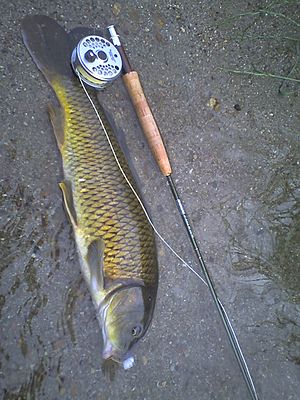
Cyprinus carpio is the third most farmed fish in the world. Only grass carp and silver carp are farmed more. China alone produces more common carp than all other fish like trout and salmon combined worldwide. About three million tons are produced each year. This makes up 14% of all farmed freshwater fish. China is the biggest producer, accounting for about 70% of all carp production. People eat carp in many parts of the world. They eat both wild carp and farmed carp.
In Central Europe, carp is a traditional part of Christmas Eve dinner. In Hungary, a special fish soup made with carp is eaten on Christmas Eve. In the Czech Republic, a thick soup made from carp's head and other parts is traditional. Fried carp with potato salad is also a popular Christmas Eve meal. This is similar in Slovakia, Austria, parts of Germany, and Poland.
In Western Europe, carp are more often raised for sport fishing. But there is also a small market for them as food. Carp are sometimes used to make gefilte fish, which is popular in Jewish cuisine. Common carp are very popular with anglers in Europe. Their popularity is also growing among anglers in the United States and southern Canada. Carp are also popular for spear fishing, bowfishing, and fly fishing.
In the U.S., most people do not eat carp. This is because they prefer fish that are already cut into fillets. Carp have small bones inside their meat, which makes them harder to cook whole.
The Romans started farming carp in ponds. This tradition continued through monasteries in Europe and is still done today. In China, Korea, and Japan, carp farming began as early as the Yayoi period (around 300 BC to AD 300).
Carp eggs, which are used for caviar, are becoming more popular in the United States.
Images for kids
See also
 In Spanish: Carpa común para niños
In Spanish: Carpa común para niños



